A Game Courier Preset for Latrunculi XXI
Rules of Latrunculi XXI
Latrunculi XXI was created by Jose Manuel Carrillo-Muniz, from Puerto Rico in 2015.
Read the full set of rules here.
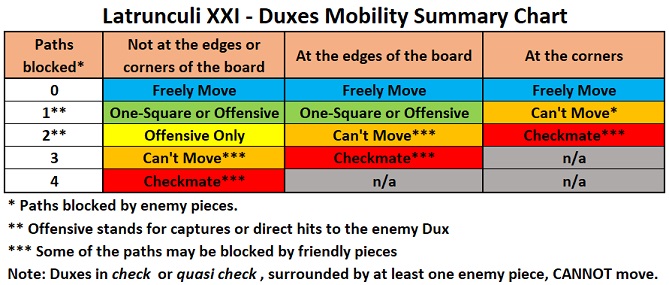
Summary of Instructions:
- The object of the game is:
- To immobilize or
- To Bare the opponent's Dux.
- However, it's illegal for a player to immobilize his own Dux.
- A player without any legal moves is stalemated and loses the game.
- All pieces move like Orthodox Chess Rooks.
- Pieces can neither play diagonally nor jump each other (like in checkers or draughts).
- Soldiers are captured by means of the custodial attacks tactic (moving in to surround an enemy soldier between two friendly pieces).
- A piece can move safely in between two enemy pieces, without being captured.
- Multiple soldiers can be captured in one turn. (example: creating multiple custodial capture situations with the same move)
- A soldier in a corner of the board can be captured if surrounded an attacked both vertically and horizontally.
- Captures are not mandatory. (just like in chess)
- Enemy Soldiers in a skirmish are locked (to the square) and cannot make any non-offensive moves.
- Locked soldiers can break the lock to make offensive moves. In other words, a soldier that is engaged in a combat can abandon his current combat post, if his move forces a capture somewhere else on the board, or a hit on the enemy Dux (see rule 19 below).
- A piece (soldier or Dux) in a melee (many-to-one combats) is allowed to move and can abandon his post to be redeployed as long as all enemy pieces he was in combat with, remain still locked in combat against other friendly piece(s).
- A piece can push a single friendly piece and crush an enemy soldier against:
- the Walls of the City, or
- another friendly piece
- The enemy soldier in the rear of a linear defensive formation can be captured by means of a directional flank attack.
- A Phalanx is a directional attack whereby the Phalanx turns into a Testudo and causes the capture of a soldier in the same orthogonal line (row or flank) and the same direction, but on the other side of the Testudo.
- A Dux in a one-on-one combat with a single enemy piece can ONLY move non-offensively one square orthogonally.
- A Dux in a two-on-one combat against two enemy pieces can ONLY make offensive moves.
- A Dux that is partially-immobilized (i.e. ONLY one orthogonal adjacent square open) cannot make any moves at all.
- A move that hits the enemy Dux is always considered as an offensive move.
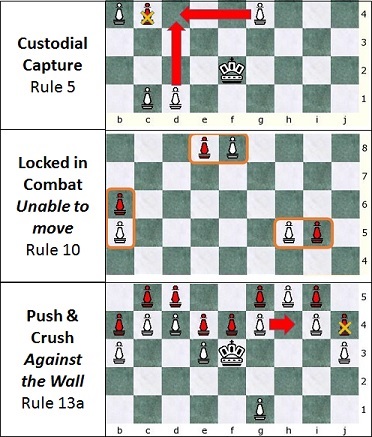
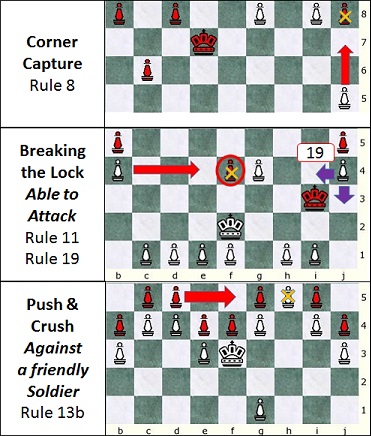
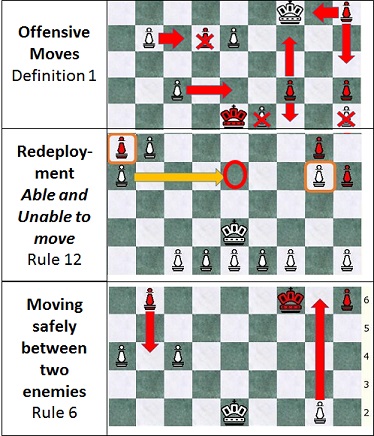
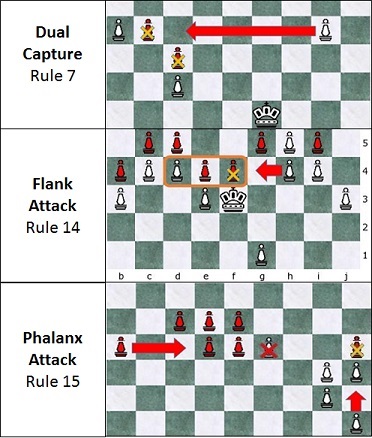
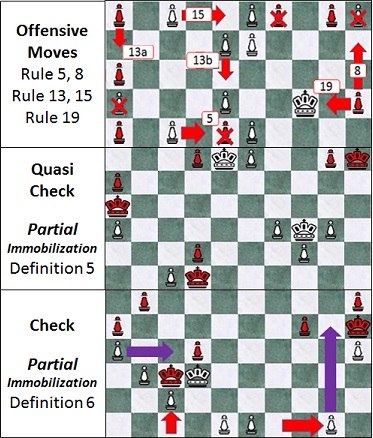
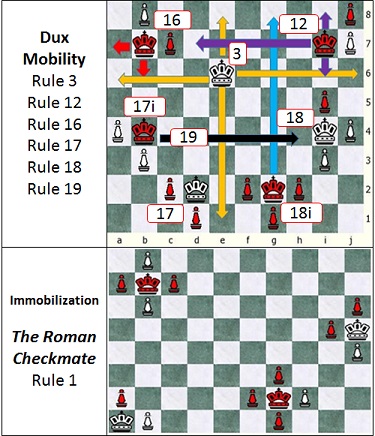
How to Move Pieces
Full Algebraic Notation
Algebraic notation identifies each space by a coordinate that begins with its file label and ends with its rank label. On the Chess board, files go up and down from one player to the other, and ranks go from left to right. In most games, files are represented by letters, and ranks are represented by numbers, but there is no fixed rule requiring this for all games, and some games, such as Shogi, reverse this convention. If you look at the diagram, you will usually see the file labels going from left to right and the file labels going up and down. And if you hover your mouse over a space, you will normally see the name of the coordinate appear in a tooltip.
It is not uncommon to see algebraic notation being used for Chess, but it is often in an abbreviated format that requires you to know both the rules of the game and the current position to know exactly which piece moves where. For example, the notation "Ne6" indicates that a Knight is moving to e6, but it doesn't indicate which Knight, and it doesn't specify where the Knight is coming from. To figure this out, you need to know how a Knight moves and which Knight on the board can make a legal move to e6.
Although rules may be programmed for individual games, Game Courier itself does not know the rules of any game, and it is unable to parse abbreviated algebraic notation. Therefore, it relies on full algebraic notation, which completely specifies the move without requiring any knowledge of the game's rules or the current position. The most usual type of full algebraic notation indicates the piece that is moving by its label, the space it is moving from, and the space it moving to. In Chess, a typical first move might be written as "P e2-e4". When you hover your mouse over a piece, you will normally see the piece label followed by the coordinate for the space, and when you hover it over an empty space, you will normally see the coordinate label. Including the piece label in your notation allows Game Courier to check that the piece you're moving is the right one, and it makes game notation easier to follow, but it is not mandatory.
You may promote a piece by including a promotion move after your regular move. A promotion move has a piece go directly to a coordinate. Here is an example: "p e7-e8; q-e8".
You may remove a piece from a space by adding an @ to the space or by omitting the destination coordinate. For example, both "@-e4" and "e4-" would remove the piece on "e4". This is useful for en passant when you are playing a game that does not handle this automatically. For example, "P d5-e6; e5-" removes the Pawn on e5 after a Pawn moves from d5 to e6.
You will not need to remove spaces for most games, but if you should need to, you can do this by omitting the first coordinate in a move. For example, "-e4" would remove e4 from the board. To add or return a space to the board, you may add an @ or any other piece to it.
Available Pieces
Pieces are represented by labels, usually using uppercase letters for White and lowercase letter for Black. When you enter a move or specify the starting position for a game, you should remember that piece labels are case-sensitive. Many piece sets are available for use with Game Courier, and this table shows you which pieces belong to the piece set you are currently using.
The inclusion of a piece does not indicate that it is used in the game you are playing. But if your game uses pieces not included here, you should choose a different piece set.






Credits
This preset uses the Set5 settings file for Latrunculi XXI, which was made by Jose Carrillo.
Game Courier was created, programmed and written by Fergus Duniho.
Game Courier, Copyright © Fergus Duniho, 2001-2017
WWW Page Created: 15 August 2001


